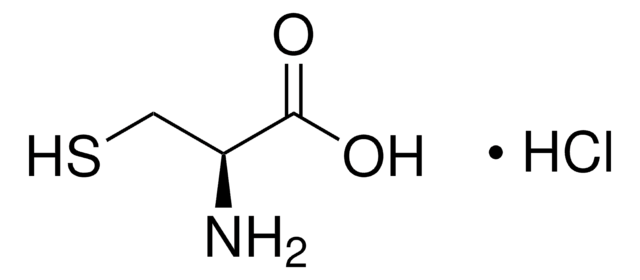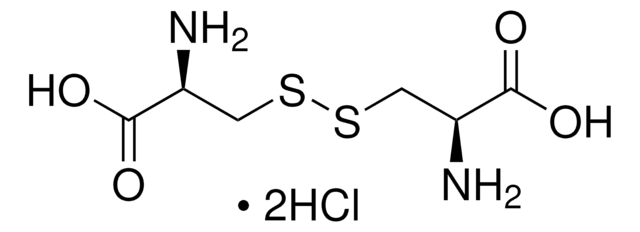C6852
L-cystéine hydrochloride monohydrate
98.5-101.0% dry basis, suitable for cell culture, non-animal source, meets EP, USP testing specifications
Synonyme(s) :
L-Cysteine hydrochloride hydrate (1:1:1)
About This Item
Produits recommandés
product name
L-cystéine hydrochloride monohydrate, from non-animal source, suitable for cell culture, meets EP, USP testing specifications
Source biologique
non-animal source
Niveau de qualité
Agence
meets EP testing specifications
meets USP testing specifications
Pureté
98.5-101.0% dry basis
Forme
powder or crystals
Activité optique
[α]20/D 6.1 to 7.8°, c = 8 in 1 M HCl
[α]25/D 5.7 to 6.8°, c = 8 in HCl (6 N)
Technique(s)
cell culture | mammalian: suitable
Impuretés
endotoxin, tested
Couleur
white
Solubilité
water: 1 g/10 mL, clear, colorless
Traces de cations
Fe: ≤10 ppm
NH4+: ≤0.02%
Application(s)
pharmaceutical (small molecule)
Groupe fonctionnel
(sulfhydryl)
Température de stockage
room temp
Chaîne SMILES
O.Cl.N[C@@H](CS)C(O)=O
InChI
1S/C3H7NO2S.ClH.H2O/c4-2(1-7)3(5)6;;/h2,7H,1,4H2,(H,5,6);1H;1H2/t2-;;/m0../s1
Clé InChI
QIJRTFXNRTXDIP-JIZZDEOASA-N
Vous recherchez des produits similaires ? Visite Guide de comparaison des produits
Catégories apparentées
Description générale
Application
Actions biochimiques/physiologiques
Caractéristiques et avantages
- Suitable for Cell Culture and Biochemical research
- High-quality compound suitable for multiple research applications
Autres remarques
Produit comparable
Code de la classe de stockage
11 - Combustible Solids
Classe de danger pour l'eau (WGK)
WGK 1
Point d'éclair (°F)
Not applicable
Point d'éclair (°C)
Not applicable
Équipement de protection individuelle
dust mask type N95 (US), Eyeshields, Gloves
Faites votre choix parmi les versions les plus récentes :
Déjà en possession de ce produit ?
Retrouvez la documentation relative aux produits que vous avez récemment achetés dans la Bibliothèque de documents.
Les clients ont également consulté
fragments by third generation intracellular
antibody capture
Articles
Antioxidants protect biological systems from oxidative damage produced by oxygen-containing free radicals and from redoxactive transition metal ions such as iron, copper, and cadmium.
Notre équipe de scientifiques dispose d'une expérience dans tous les secteurs de la recherche, notamment en sciences de la vie, science des matériaux, synthèse chimique, chromatographie, analyse et dans de nombreux autres domaines..
Contacter notre Service technique









